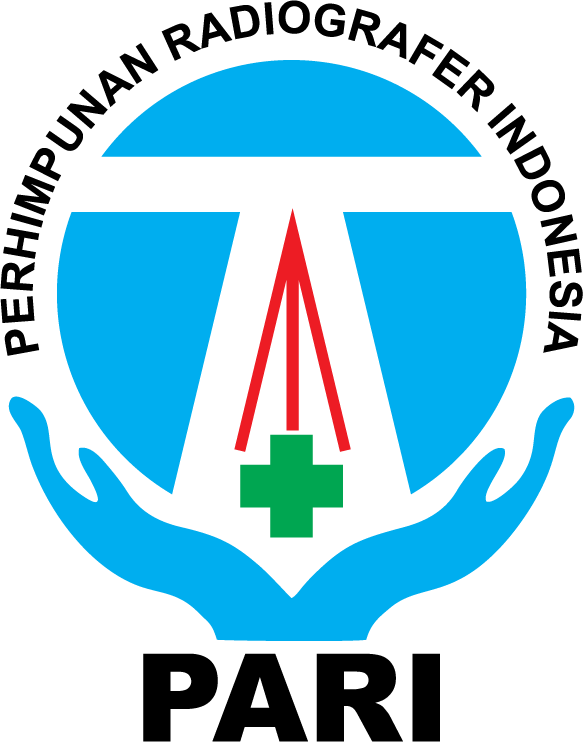PERFOMANCE TEST OF MRI MACHINES IN THE PROVINCE OF BALI
Abstract
Backgroud: The research of performance test of MRI machines were done by doing performance test of nine different parameters in three hospitals in the province of Bali, where in two of these three hospitals are having troubled MRI machines which directly affected the image quality and therefore this research is also aimed to find out the performance of MRI machines in some hospitals in the province of Bali and intended as a baseline data if there will another test.
Methods: This research is a quantitative study with survey approach. The tools and materials for this research were three MRI machines, which was consisted of two 1,5 Tesla machines and a 0,3 Tesla machine, phantom ACR, and MRI head coil. The data were collected by doing nine MRI performance testing procedures with ACR (2015) as a guideline and then the data were analyzed using international standards issued by ACR (2015).
Results: Visual checklist test result of all the hospitals get 12 pass every day from the first day to the twentieth day. SNR test in Badung Regional General Hospital obtain measurement results of 268.17 and in The Board Of Tabanan General Hospital at 15.78 and at Sanglah Central General Hospital of 2.4. To test the artifact analysis only in The Board Of Tabanan General Hospital only found one type of artifact is the artifact geometric distortion. In testing the high contrast resolution in Sanglah Central General Hospital and Badung Regional General Hospital get the same result, namely insert a separate resolution of up to a third group, and the The Board Of Tabanan General Hospital insert a separate resolution to the second group. The test results in low contrast resolution Sanglah Central General Hospital and Badung Regional General Hospital get the same result, namely that there are 10 spokes are visible, then the The Board Of Tabanan General Hospital number of spokes that appear are 9 spokes. In testing the slice thickness accuracy in Sanglah Central General Hospital get the standard deviation of measurement of 5.12mm and in Badung Regional General Hospital get the standard deviation and the measurement of 0.64mm in The Board Of Tabanan General Hospital get the standard deviation of measurement of 0.48mm. Results of the geometric accuracy test in The Board Of Tabanan General Hospital has a difference measurement of 4.2mm X axis, Y-axis of 1.3mm, and has no difference in the Z-axis, in Badung Regional General Hospital has a difference of X-axis measurement of -3.1mm, have no difference in the Y axis the Z axis of 2mm, in Sanglah Central General Hospital has a difference measurement of 1.36mm X axis, Y-axis and Z-axis of 0.39mm for -3.53mm. The test results slice position accuracy in Sanglah Central General Hospital get the standard deviation measurements for -1.33mm, in The Board Of Tabanan General Hospital of 0.85mm, and in Badung Regional General Hospital of -0.3mm. For the test setup and table position accuracy throughout the hospital to get the same measurement is 5mm.
Conclusion: Out of nine parameters in the test : only four parameters, which were high contrast resolution test, low contrast resolution test, slice position accuracy test, and setup and table position accuracy test, that met the international standards in all hospitals, whereas all the hospital didn’t meet the international standards in geometric accuracy test. There were two hospitals that didn’t meet the international standards in signal to noise ratio test, while one hospital didn’t meet the standards in artifact analysis test and slice thickness accuracy test.Keywords
Full Text:
PDFReferences
American College Radiology. 2015. Magnetic Resonance Imaging (MRI) Quality Control Manual (hal 22-100), America
American College Radiology. 2002. Site Scanning Instruction For Use Of The MR Phantom For The ACR MRI Accreditation Program (hal 5), America
Clarke D, Geoffrey. 2015. Overview Of The ACR MRI Accreditation Phantom (hal 1-9), University Of Texas Southwestern Medical Center. Dallas
Hurter, D. 2004. A Short Overview Of MRI Artefacts (hal 13-16), Departemen Of Diagnostic Radiology University Of The Free State. Bloemfontein
Hasemi, H. R and Bradley G. 1997. The Basic MRI (hal 39), Second Edition. The Williams & Wilkins: New York.
Kaljuste, Doris and Mait Nigul. 2014. Evaluation Of The ACR MRI Phantom For Quality Assurance Test Of 1.5 Tesla MRI Scanners In Estonian Hospitals (hal 329-333), Medical Physics. Estonia
NessAiver, Moriel S. 2008. The Pyhsics Components Of The ACR MRI Accreditation Program Are Overly Tedious And Beyond What Is Needed To Ensure Good Patient Care (hal 3420), Department Radiology University Of Alabama. Birmingham
Papp, Jeffry. 2006. Quality Management In The Imaging Science (hal 243- 251), Third Edition. Saint Louis : Mosby
Ruan, Chun. 2003. MRI Artifacts Mechanism And Control (hal 1-8). University of Texas Southwestern Medical Center. Dallas
Robbie, Mc. 2006. MRI From Picture To Proton (hal 1), Second Edition. Cambridge University Press. New York
Somasundaram, K. 2012. Analysis Of Imaging Artifacts In MR Brain Images (hal 136-140), Department Of Computer Science And Applications Gandhigram Rural Institute Deemend University. Tamil Nadu. India
Weishaupt, Dominik. 2006. How Does MRI Work (hal 7-42), Second Edition. Springer Berlin Hiedelberg. New York
DOI: https://doi.org/10.31983/jimed.v4i2.4000
Article Metrics
Refbacks
- There are currently no refbacks.
JURNAL IMEJING DIAGNOSTIK by http://ejournal.poltekkes-smg.ac.id/ojs/index.php/jimed is licensed under a Creative Commons Attribution-ShareAlike 4.0 International License.

.png)
.png)
.png)
.png)
.png)
.png)
.png)











